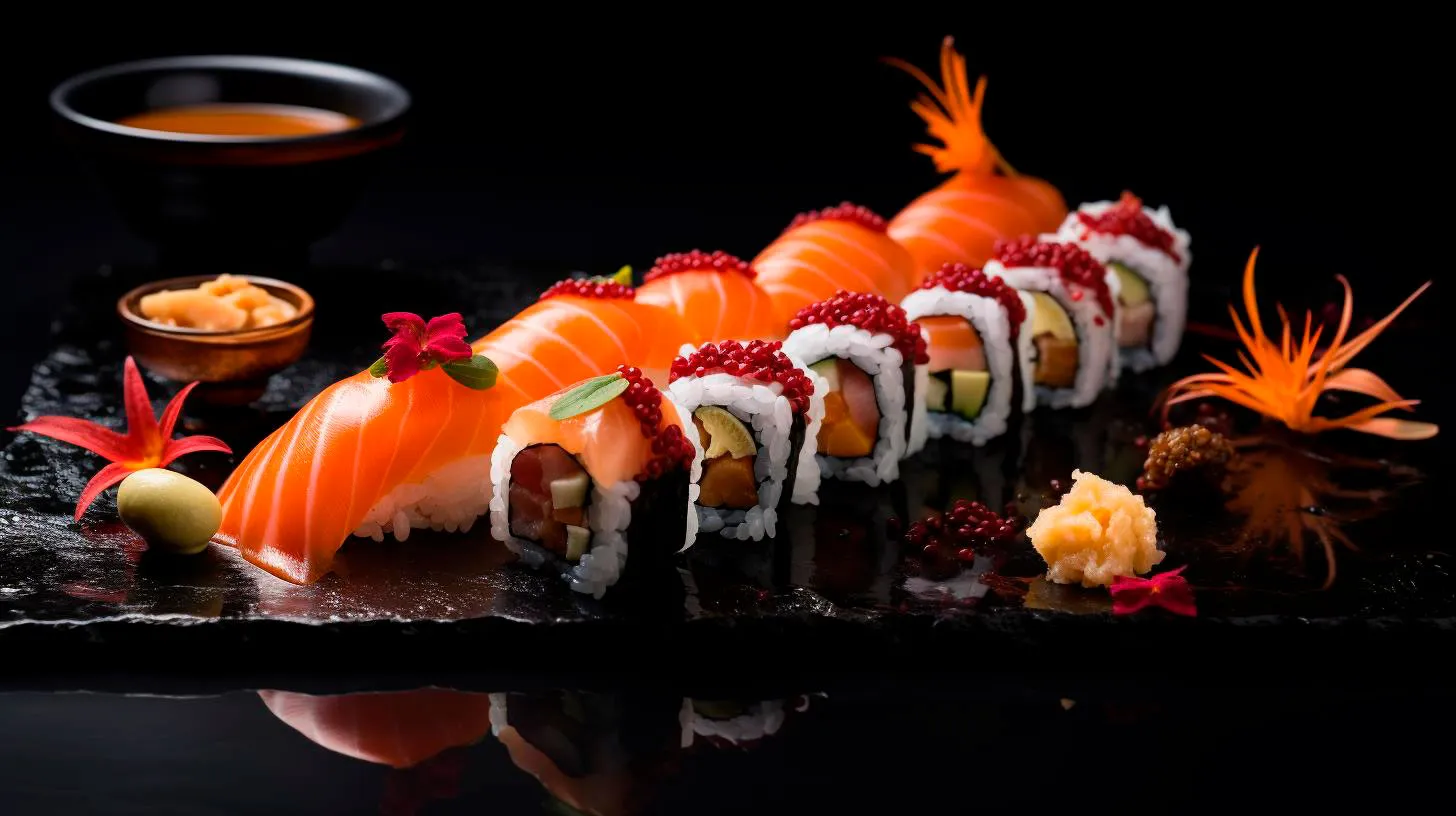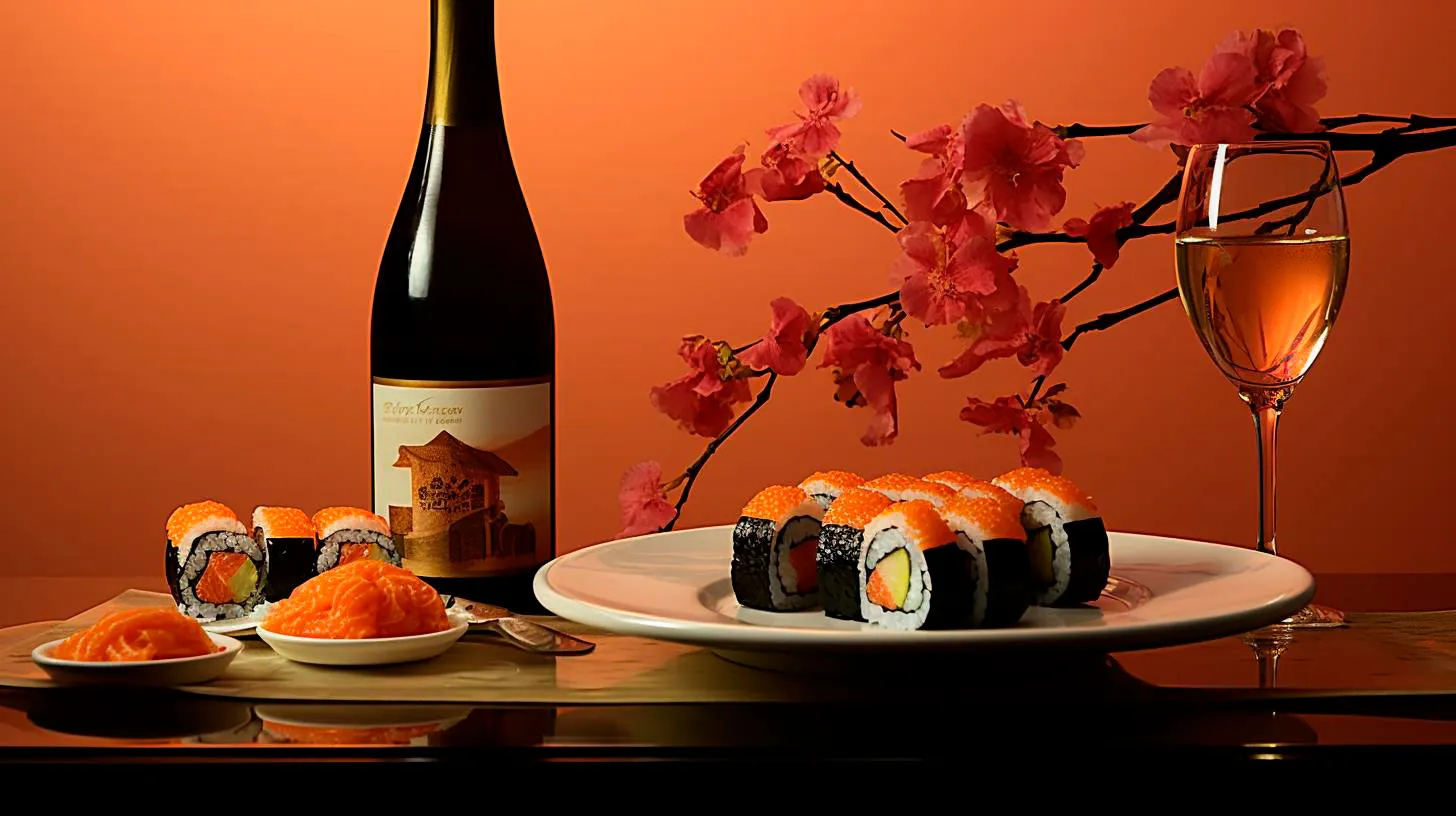Sushi as a Nutritional Powerhouse: Benefits and Ingredients
In this article, we will explore why sushi stands out as a nutritional powerhouse and the key ingredients that contribute to its overall healthiness.
The Nutritional Benefits of Sushi
Sushi is more than just a tasty meal; it is packed with numerous health benefits. By regularly enjoying sushi, you are incorporating a nutrient-rich dish into your diet. Let’s take a closer look at some of the reasons why sushi is regarded as a nutritional powerhouse:
- Rich in Omega-3 Fatty Acids: One of the standout nutritional benefits of sushi lies in its inclusion of fatty fish, such as salmon, tuna, and mackerel. These fish are abundant in omega-3 fatty acids, which are known to support heart health, reduce inflammation, and promote brain function.
- Excellent Source of Protein: Sushi is generally made with raw fish or seafood, providing a substantial amount of protein. Protein plays a crucial role in building and repairing body tissues, promoting muscle growth, and supporting a healthy immune system.
- Prevents Vitamin Deficiencies: Sushi often includes a variety of vegetables, such as cucumber, avocado, and seaweed. These ingredients are rich in essential vitamins and minerals that contribute to overall well-being. For instance, seaweed is an exceptional source of iodine, which supports healthy thyroid function.
- Low in Saturated Fat: Compared to many Western dishes, sushi is generally low in saturated fat. This makes it a healthier option for individuals who are conscious of their cholesterol levels and overall fat intake.
- Promotes Digestive Health: Sushi’s inclusion of pickled ginger and fermented soy sauce known as “shoyu” contains probiotics that aid in digestion and promote a healthy gut flora.
Key Ingredients in Sushi
What sets sushi apart are the exceptional ingredients used in its creation. Each component plays a crucial role in creating the perfect balance of flavors and ensuring a wholesome culinary experience. Here are some key ingredients commonly found in sushi:
1. Nori
Nori is dried seaweed that serves as the outer wrapping for various sushi rolls. It is a rich source of iodine and other minerals, offering numerous health benefits.
2. Rice
Sushi rice, also known as ‘sumeshi’, is the foundation of any sushi dish. It provides a source of carbohydrates for energy and is seasoned with vinegar to enhance the overall taste.
3. Fish and Seafood
Fresh, high-quality fish and seafood, including salmon, tuna, shrimp, and octopus, are the highlight of most sushi creations. They provide abundant omega-3 fatty acids and protein.
4. Vegetables
A variety of vegetables are commonly used in sushi, making it a well-rounded and nutritious meal. Examples include cucumber, avocado, and radish, which provide important vitamins and minerals.
5. Wasabi and Ginger
These condiments are often served alongside sushi. Wasabi, made from Japanese horseradish, provides a distinctive spiciness and potential antibacterial properties. Pickled ginger, on the other hand, aids in digestion and adds a refreshing flavor.
Next time you enjoy a sushi meal, take delight in knowing that it not only satisfies your taste buds but also contributes to your overall well-being. With its array of health benefits and top-notch ingredients, sushi truly deserves its reputation as a nutritional powerhouse.
Key Takeaways:
- Sushi is a nutrient-rich dish packed with health benefits.
- It is an excellent source of omega-3 fatty acids and high-quality protein.
- Sushi includes a variety of vegetables that prevent vitamin deficiencies.
- It is low in saturated fat, making it a healthier food choice.
- Consuming sushi promotes digestive health due to the presence of probiotics.
- Key ingredients in sushi include nori, rice, fish and seafood, vegetables, wasabi, and ginger.
- Nori provides iodine and minerals, while rice serves as the foundation.
- Fish and seafood offer omega-3 fatty acids and protein.
- Sushi vegetables provide essential vitamins and minerals.
- Wasabi and ginger offer unique flavors and potential health benefits.
Embrace the nutritional benefits of sushi and savor its delectable flavors for a delightful and health-conscious dining experience.
From Traditional to Modern Innovations in Sushi-making Techniques
In this blog post, we will explore the journey of sushi-making techniques and highlight the advancements that have revolutionized sushi creation.
The Traditional Foundations of Sushi
Sushi making dates back to ancient times when it was primarily a means of preserving fish. During the Muromachi period (1336-1573), fermented rice was used to store fish, creating a methodology that eventually gave birth to the initial sushi-making techniques we know today.
In the Edo period (1603-1868), sushi as we now recognize it gained prominence. Nigiri sushi, the popular hand-pressed style, became popular in Edo (now Tokyo). It is a delicately molded portion of rice topped with fresh fish or other ingredients. This approach brings out the umami flavor and highlights the quality of the fish perfectly.
The Advancement of Sushi Techniques
While traditional sushi-making techniques remain an integral part of the process, the modern advancements in technology and creativity have revolutionized the industry. Let’s explore some modern innovations that have transformed sushi-making:
- Sushi Robots: With the introduction of sushi robots, repetitive tasks, such as rice molding and rolling, are now automated. These machines efficiently shape rice into perfect mounds, ensuring consistency in size and texture.
- Sushi Conveyor Belts: Conveyor belt sushi restaurants have gained popularity worldwide. These innovative establishments allow diners to select their favorite dishes directly from a rotating belt, ensuring a quick and seamless dining experience.
- Molecular Gastronomy: Modern chefs have embraced the concept of molecular gastronomy to push the boundaries of sushi making. Techniques like spherification and foams have been incorporated to create visually stunning and flavorful sushi creations.
The Benefits of Modern Innovations
While honoring tradition is important, modern innovations in sushi-making techniques offer numerous advantages that enhance the overall sushi experience. Here are some key benefits of these new approaches:
- Efficiency and Consistency: Sushi robots significantly reduce the time and effort required for repetitive tasks, ensuring consistency in each sushi piece prepared.
- Enhanced Dining Experience: Conveyor belt sushi allows customers to conveniently select their preferred dishes, enhancing the overall dining experience and offering a wide variety of choices.
- Creativity and Presentation: The use of molecular gastronomy techniques adds an innovative touch to sushi, enabling chefs to create visually stunning and unique flavor combinations.
Key Takeaways
Sushi-making techniques have come a long way from their traditional origins, evolving through time to accommodate modern requirements and innovative approaches. Incorporating sushi robots, conveyor belts, and molecular gastronomy have injected freshness and efficiency into this beloved culinary art.
Despite these advancements, it is essential to remember the importance of preserving sushi’s traditional foundations and respecting the skill and craftsmanship involved. The marriage between tradition and innovation allows us to enjoy sushi in new and exciting ways while maintaining the essence that has captivated generations.
Next time you savor a meticulously crafted piece of sushi, appreciate the blend of traditional techniques and modern innovations that have made this delicacy an exquisite culinary experience.
The History and Cultural Significance of Sushi
The Origins of Sushi
Sushi, as we know it today, has a fascinating history that dates back centuries. While it is often associated with Japan, its origins can be traced back to Southeast Asia. The concept of sushi began as a preservation method to keep fish fresh.
During the 8th-century, people in Southeast Asia discovered that when fish was stored in fermented rice, it resulted in a delicious and preserved dish. This early form of sushi was known as “nare-zushi,” and the rice was discarded before consuming the fish. Over time, this method of preservation made its way to Japan.
Edo Period: The Birth of Modern Sushi
In the 19th century during the Edo period, sushi underwent a significant transformation. Hanaya Yohei, a sushi chef in Tokyo, introduced a new type of sushi that revolutionized the culinary world. This style, known as “Edo-mae sushi,” featured vinegared rice and raw fish in bite-sized portions.
The introduction of Edo-mae sushi coincided with the increasing popularity of Tokyo as a center for trade and commerce. The quick and convenient nature of sushi made it a hit among busy workers who needed a fast and nutritious meal. Sushi bars or “sushiya” started to emerge during this period, establishing sushi as a staple part of Japanese cuisine.
Cultural Significance of Sushi
Although sushi is now enjoyed worldwide, it still holds deep cultural significance in Japan. Here are some key reasons why sushi is so important to Japanese culture:
- Artistry and Presentation: Sushi is not just about the taste but also about the visual presentation. Sushi chefs take great pride in the artistry of creating beautifully arranged sushi. Every piece is carefully crafted to enhance the dining experience.
- Harmony and Balance: Japanese cuisine emphasizes the principles of balance and harmony. Sushi embodies this philosophy through the combination of flavors, textures, and colors. The delicate balance of fish, rice, and other ingredients is what enhances the overall experience.
- Seasonality: Sushi showcases the importance of seasonality in Japanese cuisine. The choice of fish and other ingredients in sushi is often influenced by what is fresh and in season. This ensures the highest quality and the most authentic flavors.
- Social and Bonding: Sushi is often enjoyed in social settings, bringing people together to share a meal. The art of sushi-making encourages interaction between the chef and the guests, fostering a sense of community and togetherness.
Key Takeaways
Sushi has come a long way from its humble beginnings as a preservation method to becoming a global phenomenon. Here are some of the key takeaways about the history and cultural significance of sushi:
- Sushi originated from Southeast Asia as a preservation method for fish.
- The Edo period in Japan saw the birth of modern sushi as we know it today.
- Sushi is not only about taste but also about artistry, balance, and seasonality.
- Sushi holds deep cultural significance and is often enjoyed in social settings.
Overall, sushi is more than just a dish. It represents the rich history, meticulous craftsmanship, and cultural values of Japan. Whether you are a sushi lover or new to this culinary delight, understanding its history and cultural significance adds another layer of appreciation to this beloved cuisine.



